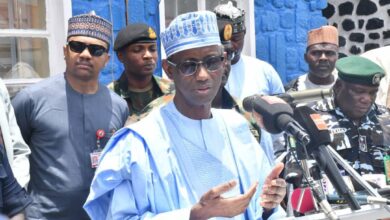
By Richard Ogundiya
Not too long ago, news about the Ministry of Agriculture’s proposed ‘RUGA Settlements’ broke, evoking outrage sparked by tribal and religious sentiments that fueled misconceptions, debates and misunderstanding of what the program was set to achieve.
The nomenclature seemed to be part of the problem: Ruga is a Hausa word that means “a Fulani settlement”. With a raging sentiment founded on ignorance and ethnic division, an internal form of xenophobia, against the Fulani ethnic group, more or less because President Buhari is one, the term Ruga it seemed would not fly in many parts of the country. Yet the concept, though inchoate, if well thought-out, planned and deployed was aimed at placating clashes between herders and farmers. Herders and their cattle are accused – and most times rightly so – of illegal grazing activities on farmers’ farmlands. This has been scientifically blamed on environmental and demographic forces, especially desertification caused by climate change and population explosion. The proliferation of small and light weapons in the intense competition for land and resources have further aided criminals and marginalized groups to capitalize on the conflicts; thus there has been the consequent rise in cattle rustling, kidnapping, armed robbery, insurgency, rural banditry and ethnic militia. Given that host communities (including farmers) have access to sophisticated weapons, minor disagreements or provocation often degenerate into violent clashes causing widespread destruction of property and human casualties.
According to the Global Terrorism Index (GTI, 2018), nearly 1,700 violent deaths have been attributed to clashes between herdsmen and farmers between January and September 2018, six times more people than those killed by the terrorist group Boko Haram in that same year.
Land scarcity, the over use of resources, and climate change have dried up fertile land in many parts of Northern Nigeria which the Fulani have historically used for grazing, driving many of these pastoralists into other states inhabited by farmers; crop yields of Nigeria’s middle belt and southern-based farmers are threatened due to the increased presence of cattle roaming on farmlands. The Fulani herders are mostly ascribed the Muslim identity, while the farmers are predominantly ascribed the Christian identity, seamlessly adding a religious dimension to the conflict over resources. These farmers, especially those in the southern parts of the country perceive the influx of “Muslim” herders as an Islamization drive. Hate speech has also become an accelerator of violent conflicts alongside the phenomenon of fake news worsening its negative impact. As such, the insecurity and unavailability of land in both Nigeria’s northern and southern states has the long-term potential to disrupt the country’s agricultural and livestock economy
But it has always been a looming crisis. Back in 1965, the Northern Region Government created a ‘Grazing Reserve System’ with over 417 grazing areas across the north. Under this structure, the government provided space, water and vaccinations for the livestock while the herdsmen paid taxes in return. However, the discovery of oil and subsequent exploration made Nigeria an oil rich economy, particularly in the 1970s and 1980s spawning an abandonment of the project. As a fallback, herdsmen began to resort back to their traditional and seasonal grazing routes which had been interrupted by industrialization, urbanization and other natural factors marking the beginning of a decades-long conflict between farmers and host communities. Till date, these clashes have been on the increase and now constitute one of the major threats to Nigeria’s national security.
As part of measures to end the persistent friction that has claimed lives and properties, states like Benue and Taraba began enacting legislations prohibiting open grazing within their borders. This, they hoped would reduce the risk of herdsmen destruction of farm lands and the associated attacks causing displacement and loss of many lives. But little or no progress has been made; while the clashes seem to rear its head every now and then.
The contest has thus created 2 key gaps in Nigeria’s agricultural practice – first, an inability to meet domestic food requirements and second, an inability to export at quality levels required for market success. One of the Federal Government’s approaches to curb this dilemma and protect lives as well as the nation’s food security is the development of the National Livestock Transformation Plan, which many still confuse as RUGA. [ Recall that the Ruga Model Settlement was suspended by the President, as it was said not to have been in accordance with the already approved plan by the National Economic Council, the National Food Security Council and the Federal Executive Council’s National Livestock Transformation Plan (NLTP). It was also a unilateral implementation by the Ministry of Agriculture.
The NLTP commissioned by the National Economic Council which Vice President Yemi Osinbajo chairs is a blueprint that will support and strengthen the development of market-driven ranches in the livestock ecosystem for improved productivity through breed improvement, pasture production, efficient land and water capacity enhancements. The scheme seeks to provide a similarly conducive habitation for nomadic herders and those who rear livestock using a private public partnership model for its set up. It is designed to create a basis for leading agribusiness companies to emerge along the lines of Brazil’s JBS, The USA’s Perdue or the Sino – American Smithfield. Most importantly, the scheme will, to a great extent, stop the spread of violence and insurgency in the affected regions, by simply keeping herders away from the farms of farmers. It potentially would aid significant boost in Nigeria’s agricultural productivity, a sector that currently employs about 38% of the total working population and accounts for a large share of our Gross Domestic Product (GDP). It is killing two birds with a stone; restore peace in the region and create more wealth for the those in the line of farming and livestock business.
Contrary to speculations, NLTP benefits all involved, from the farmers to those in animal husbandry and not just cattle herders; with no intent of enforcing the project on any states, as states are not just at liberty to adopt, they are expected to develop their own home grown plans for implementation. The FG’s Plan is to settle them in an organized place with basic amenities like schools, hospitals and veterinary clinics, thereby adding value to meat, diary and other animal products. The project is voluntary for all 36 States, with options of presenting their unique delivery mechanisms according to their respective challenges. To be clear, while a number of states in the conflict zones will receive high levels of attention, the purpose of NLTP is to catalyze a transformation in livestock production systems across Nigeria in a defined and effective manner. However, the process will continue to require an expansion of the role of private capital and investors, accelerating the rate of formation of small and medium sized enterprises and improvements in overall condition of doing agribusiness.
Recent estimates puts Nigeria’s livestock population at 19.8 Million cattle, 43.4 Million sheep, 76 Million goats and 213 Million poultry, all under traditional pastoral management – the reason our productivity is amongst the lowest globally. Thus the need for commercial ranching models for a country with 250 million people by 2030. Nearly 60 percent of the ruminant livestock population is found in the country’s semi-arid zone and mostly managed by pastoralists. Domestic production of livestock products is far below the national demand, resulting in large imports of livestock and its products. The annual expenditure on food exportation amounts to USD 3-5 Billion annually putting pressure on the National foreign exchange with milk importation alone amounting to USD 1.3 Billion per annum. Except for eggs, the domestic production of animal products is less than half the demand for beef mutton and goat meat, while for milk and pork products it is less than quarter the demand.
The livestock industry development is constrained by low productive breeds, inadequate access to feeds and grazing lands, lack of processing facilities, low value addition and technical inputs in the management of the animals, diseases and conflicts.
The NLTP’s agenda is to to create new opportunities for farmers and provide more affordable and healthier diets for future generations. Managing this growth also requires a complex institutional response that can stimulate income and employment opportunities in the rural areas, protect the livelihoods of small farmers, improve resource-use efficiency at all levels of the value chain, minimize negative environmental and health consequences, and ensure adequate access by the poorer sections of society to the food they need to live healthy lives.
NLTP plays an integral role in revolutionizing how livestock farming is practiced and its effect on the nation’s economy, social well-being of its citizens and huge export capacity. Its implementation strategy identifies five main pillars as priority areas: Conflict Resolution, Justice and Peace, Humanitarian relief, Human Capital Development and issues on Gender, Youth, Research Information and Strategic Communication.
As the decades old conflicts between farmers and pastoralists surface and resurface every now and then, a sustainable solution must be designed, one that equally looks at the big picture that caters for the economic opportunities that come with pastoralism and husbandry, while also developing the needed human capital for the long term. This is what the National Livestock Transformation Plan ultimately seeks.
The needless sentiments that followed the RUGA scheme must be put aside as the Federal Government looks into the implementation of this programme alongside willing states. Ethnic, tribal and bigotry-defined points of view must be set aside to accommodate the NLTP’s long-term solution. Needed stakeholder consultations have been made through the National Economic Council, with input from traditional rulers and relevant stakeholders of cattle breeders and farmers associations. It is expected that Governors and these stakeholders carry the message of peace, reconciliation and development that the NLTP brings to their states and their local communities to ensure there is understanding and buy-in of it before acceptance. This is where Ruga failed. Nigeria needs the NLTP as much as it seeks peace, stability and development.
Richard Ogundiya is a journalist and researcher, and writes from Lagos.





